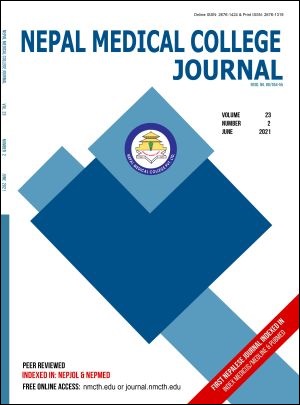Association between Leptin and Adiponectin in women with Polycystic Ovary Syndrome in North Indian Population
DOI:
https://doi.org/10.3126/nmcj.v23i2.38570Keywords:
Polycysitc Ovary Syndrome, Women, PCOS, Adiponectin, Leptin, North IndiaAbstract
Polycystic ovary syndrome (PCOS) is one of the most common endocrine abnormalities, characterized by biochemical hyperandrogenaemia, chronic anovulation, and polycystic ovaries. The objective of the present study to determine the association of adiponectin and leptin with women with PCOS in North Indian Women. In the hospital-based case-control study 100 women with PCOS and 100 controls were recuited from RAMA Medical College, Kanpur, India. Five ml venous blood sample was collected under aseptic precaution and transferred in the serum separator tubes. Leptin and adiponectin levels were assayed by human sensitive leptin double-antibody sandwich enzyme-linked immunosorbent one-step process assay (QAYEE-BIO life science) according to instructions provided with the kit. In the multivariable logistic regression analysis, leptin was found to be independently associated with 1.14 times higher risk for PCOS (OR 1.14, 95% CI 1.01 to 1.29). Receiver operating curve (ROC) analysis suggested excellent predictive accuracy of the multivariable model with Area under the curve 0.86. In the ROC analysis leptin was associated with 68% area under the curve for predicting PCOS using cut off value of >7.87, (P<0.001, Sensitivity 87.8, Specificity 49.4). Adiponectin level was not significantly associated with predicting PCOS (Area under the curve 0.54, P =0.30, Sensitivity 71.1, specificity 50.5, cut off value <10.2). To conclude we observed that higher leptin levels were independently associated with the risk of PCOS, however adiponectin level was not independently associated with the risk of PCOS.
Downloads
Downloads
Published
How to Cite
Issue
Section
License
Copyright (c) 2021 Nepal Medical College Journal

This work is licensed under a Creative Commons Attribution 4.0 International License.
This license enables reusers to distribute, remix, adapt, and build upon the material in any medium or format, so long as attribution is given to the creator. The license allows for commercial use.




